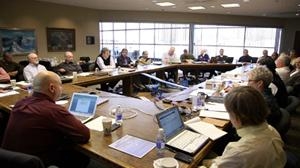Sat, Feb 01, 2014
More Than A Dozen FAA Directors And Managers Gathered In Oshkosh Over Two Days
Clearing the path for today's aviators and looking ahead to the possibilities in future years highlighted two days of work by EAA and FAA officials during the 10th annual Recreational Aviation Summit, held at the EAA Aviation Center on Tuesday and Wednesday.

The session brought more than a dozen top FAA directors and managers to Oshkosh, the only time during the year that the agency sends such a group to a specific aviation organization's headquarters for in-depth discussions on major GA topics. FAA officials from aircraft certification, flight standards, accident prevention, the small airplane directorate and other areas were represented. EAA chairman Jack Pelton led the EAA team, which included senior leaders and representatives from all interest communities within the organization.
"These two days are very important for EAA members because it allows us to have the FAA management and policy teams get away from Washington and focus directly on the issues that are most important to our members," said Sean Elliott, EAA's vice president of advocacy and safety. "One impressive highlight was how open the FAA team was to emerging technology for creating opportunities for that to be implemented across various segments of general aviation."
Among the issues discussed during the summit's two days were:
- Allowing electric propulsion for ultralights and light-sport aircraft, and clearing regulatory hurdles that prevent today's electric motor technology from emerging
- Current conflicts in regulations that limits the availability to provide flight training for ultralights and other low-mass, high-drag aircraft, so those areas of aviation can become more vibrant and safe
- An option for use of an additional qualified pilot during homebuilt flight testing, which would add an additional opportunity to enhance safety and best practices in those initial flying hours
- Incompatibility issues for ADS-B and NextGen technology, where pilots are spending significant dollars for future mandated equipment but cannot ensure that it is supplying the correct data
- Warbird operating limitations that potentially hinder how warbird owners can use their aircraft or add significant cost and complexity to their maintenance and operation
"These were just a few of the items discussed in detail with the FAA team," Elliott said. "More importantly, the winter summit also gives a detailed action plan that allows us to follow up with the FAA in the coming weeks and months to ensure that these important items don't fall through the cracks."
EAA officials also again expressed the urgency of improving the medical certification system, as presented by EAA and AOPA nearly two years ago as an exemption request, and more recently in Congress as legislation that would eliminate the need for a third-class medical for many recreational aviation activities. While the exemption request is being reviewed, the FAA, has asked EAA and its members to help compile data as part of an ongoing safety measurement and enhancement effort.
(Image provided in EAA news release)
More News
Aero Linx: American Aviation Historical Society AAHS is dedicated to the preservation and dissemination of the rich heritage of American aviation. Our purpose is to collect, preser>[...]
CrewMember (UAS) A person assigned to perform an operational duty. A UAS crewmember includes the remote pilot in command, the person manipulating the controls, and visual observers>[...]
Immediately After The Right Main Tire Contacted The Runway Surface, The Right Main Landing Gear Failed On October 31, 2025, at about 1227 Pacific daylight time, a Maule M-7-235A, N>[...]
Also: IAE Acquires Diamond Trainers, Army Drones, FedEx Pilots Warning, DA62 MPP To Dresden Tech Uni The danger to the flight training industry and our future pilots is clear. Dona>[...]
"On December 3, 2025, at approximately 10:45 a.m., a Thunderbird pilot ejected safely from a F-16C Fighting Falcon aircraft during a training mission over controlled airspace in Ca>[...]
 ANN's Daily Aero-Linx (12.03.25)
ANN's Daily Aero-Linx (12.03.25) ANN's Daily Aero-Term (12.03.25): CrewMember (UAS)
ANN's Daily Aero-Term (12.03.25): CrewMember (UAS) NTSB Prelim: Maule M-7-235A
NTSB Prelim: Maule M-7-235A Airborne-Flight Training 12.04.25: Ldg Fee Danger, Av Mental Health, PC-7 MKX
Airborne-Flight Training 12.04.25: Ldg Fee Danger, Av Mental Health, PC-7 MKX Aero-News: Quote of the Day (12.04.25)
Aero-News: Quote of the Day (12.04.25)



